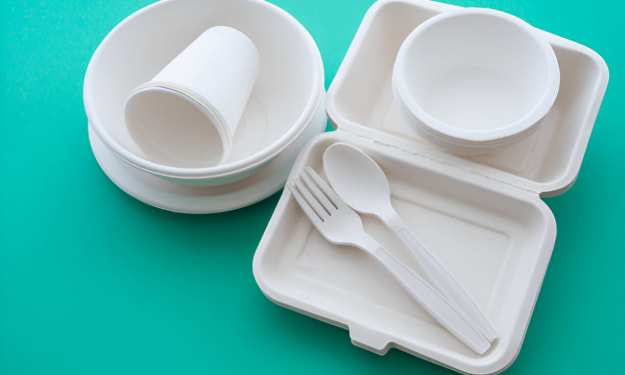The Ultimate Guide to Proper Disposal and Recycling of Sugarcane Plates: Expert Tips and Techniques
Expert Knowledge: Disposal and Recycling of Sugarcane Plates

Introduction
Recent years have seen a shift in the global mindset towards sustainable living, largely due to growing environmental concerns. Eco-friendly products are becoming more popular as a result of this trend, and offer consumers an eco-friendly way to meet their daily needs. Sugarcane plates are one such eco-friendly product. They are also called bagasse plates. This comprehensive guide will examine the benefits of using sugarcane plates, as well as proper disposal methods, recycling options, and how these practices can contribute to a healthy planet.
Sugarcane Plates Overview
The sugarcane plates are a shining example of sustainable innovation. These plates are made from bagasse, a fibrous byproduct that is left after the extraction of sugarcane juice. They offer an eco-friendly and sturdy alternative to disposable plates. Bagasse is renewable, so using it to make plates reduces waste and minimizes the need for virgin materials. Sugarcane plates can be composted and are biodegradable. They're a great choice for environmentally conscious consumers.
The Environmental Impact of Improper Disposal
The improper disposal of disposable dishes, particularly those made of plastic or paper, can have severe environmental effects. Plastic plates decompose slowly, taking hundreds of years. This contributes to marine pollution and can harm marine life. Paper plates can also cause habitat loss and deforestation if they are not properly disposed of. In addition, the accumulation of nonbiodegradable materials in landfills exacerbates this problem by releasing harmful greenhouse gases into the air.
Proper Disposal Techniques for Sugarcane Plates
To maximize the environmental benefits of sugarcane plates, it is important to dispose of them properly. Sugarcane plates can be disposed of in the most environmentally friendly way by composting. Composting sugarcane plates breaks them down into organic matter. This enriches the soil and closes the nutrient cycle. Sugarcane plates may also be disposed of in landfills where they decompose more quickly than plastic alternatives. Sugarcane plates can be incinerated to generate energy.
Options for Recycling Sugarcane Plates
Recycling sugarcane plates can be a sustainable alternative to composting. Recycling facilities can break down sugarcane plates into pulp that can be used for manufacturing new plates or paper products. Some waste management companies specialize in the processing of biodegradable plate waste, such as sugarcane plate waste, into compost and biofuel. Sugarcane plates are accepted by industrial recycling programs, which diverts them from landfills.
It is important to recycle sugarcane plates efficiently to reduce the environmental impact. Here are some expert recycling tips:
Cleaning: Before recycling the sugarcane plates ensure that they are clean and free of food residues. To prevent contamination of the recycling stream, rinse them with water or clean them using a rag. Clean plates will be more readily accepted by recycling facilities, and produce higher-quality recycled material.
Separation Keep plates made of sugarcane separate from other waste types to make recycling easier. To avoid mixing biodegradable plates with non-recyclable items, create a bin or designated area for sugarcane plate items. Separating materials properly streamlines recycling and reduces sorting.
Check Local Requirements: Learn about local recycling regulations and guidelines regarding the disposal of sugarcane plate products. Some recycling facilities have restrictions or requirements for accepting biodegradable plates. Understanding the rules will ensure proper disposal, and avoid contamination issues.
Bulk Recyclage: When possible, recycle plates made of sugarcane in large quantities. Consolidating recyclables can reduce transportation costs and associated emissions. For greater efficiency, consider coordinating with your neighbors or local businesses.
Support recycling initiatives: Promote the recycling of biodegradable plates like sugarcane plates. Support the expansion of recycling infrastructure in your area and investments in composting facilities. Participate in local campaigns or recycling programs to encourage waste management and raise awareness.
Techniques for Reusing Sugarcane Plates
Reusing sugarcane dishes not only encourages creativity but also reduces waste. Here are some useful techniques for reusing plates made of sugarcane:
Art and Crafts Discover your creative side with sugarcane plates. You can cut them into various shapes to make handmade greeting cards, paper-mache sculptures, or decorative ornaments. Transform sugarcane plates into unique art by letting your imagination run free.
Party Decor: Add a green twist to your party by using sugarcane plates as decorations. They can be cut into bunting flags or party hats. Decorate plates using eco-friendly markers or paints for a stylish, yet sustainable party theme.
Food presentation: Use sugarcane dishes to present food at events or gatherings. Sugarcane plates are a great way to serve rustic, eco-friendly snacks, desserts, or appetizers. These plates add charm to any event while reducing single-use plastic waste.
Seedling Trays: Turn sugarcane plates into biodegradable seedling starter trays. Plant seeds directly in the trays after cutting the plates into sections and filling them with potting dirt. When the seedlings have grown, you can transplant them directly into the soil.
Fun and Educational Activities: Use sugarcane plates to engage children in educational and fun activities. You can use them as props for stories, DIY games, science experiments, or other educational activities. Sugarcane plates can be used to teach kids about eco-friendly practices and sustainability.
The environmental benefits of Proper Disposal & Recycling:
The proper disposal and recycling of sugarcane plates offer numerous environmental benefits, that go beyond the reduction of waste. We can reduce pollution and climate change by adopting responsible waste management. Proper disposal and recycling is beneficial to the environment.
Waste reduction: Composting and recycling sugarcane plates reduces waste sent to landfills. Landfills emit greenhouse gases, such as methane. Methane is a powerful contributor to climate change. We can reduce greenhouse gas emissions by diverting organic waste, such as sugarcane plates, from landfills.
Resource Conservation: Recycling sugarcane plates conserves valuable natural resources. Water, energy, and raw materials are used in the production of disposable plastic or paper plates. We can reduce our dependence on virgin materials by recycling sugarcane plates. This will also have a lessening of the environmental impact.
Energy savings: Recycling sugarcane plates uses less energy than producing plates from raw materials. Recycling materials uses fewer resources, emits less pollution, and reduces carbon emissions. We can conserve energy and encourage sustainable resource usage by supporting recycling initiatives.
Soil enrichment: Composting of sugarcane plates enhances the soil's health. Organic waste releases nutrients into the soil when it decomposes. This increases its fertility and structural integrity. Composted organic matter increases soil moisture retention and reduces erosion. It also supports healthy plant growth. We can reduce the use of chemical fertilizers by returning nutrients to the soil. These can have negative effects on water quality and ecosystems.
Water conservation: Recycling sugarcane plates reduces water-intensive manufacturing processes. The production of traditional disposable plates requires large quantities of water to wash, produce pulp, and other manufacturing processes. We can conserve water by recycling sugarcane plates. This reduces the pressure on freshwater ecosystems, and water pollution from industrial activities.
Wildlife protection: Proper recycling and disposal of sugarcane plates helps protect wildlife and habitats. Plastic and paper plates that are not properly disposed of can end up in rivers or oceans and pose a threat to wildlife and marine life. We can reduce environmental contamination by choosing eco-friendly options like sugarcane and disposing of them properly.
Climate Change Mitigation: Effective practices in waste management, such as recycling and composting, are crucial to mitigating climate change. We can help combat climate change by reducing landfill emissions, conserving natural resources, and promoting sustainable practices.
Conclusion
Sugarcane plates are a sustainable and environmentally friendly alternative to disposable plates. They reduce our carbon footprint significantly. We can make our planet cleaner and healthier by adopting the right disposal methods, exploring recycling options, and finding creative ways to reuse plates. Switch to sugarcane and be proactive in moving towards a sustainable future.
About the Creator
planet plates
We are a dedicated team committed to producing high-quality eco-friendly tableware products to reduce plastic usage and create a greener and cleaner Earth.
Enjoyed the story? Support the Creator.
Subscribe for free to receive all their stories in your feed. You could also pledge your support or give them a one-off tip, letting them know you appreciate their work.






Comments
There are no comments for this story
Be the first to respond and start the conversation.